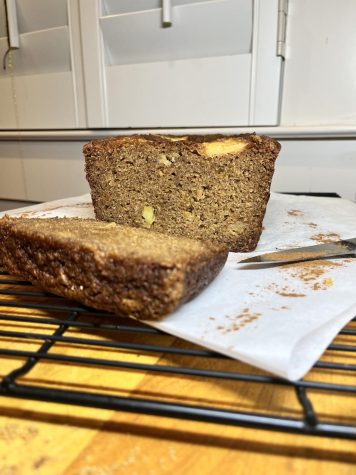Falling into Autumn Baking: Science of Quick Breads
It is officially fall, the season of pumpkin spice lattes, falling leaves, and sweaters. Let me set the scene: it’s a gray overcast day, the rain pattering lightly on the window as you bake, a steaming hot cup of tea next to you, and Taylor Swift playing in the background. To me, that is the definition of an ideal autumnal evening.
When baking in the fall, I love to incorporate warm spices into my goods, and also produce that’s in season. One easier category of recipes that is a great addition to any amateur baker’s repertoire is quick breads. Not only are they relatively easy to make and mainly use common pantry items, but they are also delicious!
Quick breads refer to breads that are leavened, or get their rise/fluffiness, from chemical leavening agents rather than a natural leavener. This usually implies the use of baking soda (sodium bicarbonate) or baking powder, rather than yeast or sourdough levain (starter). The advantage of this is that the process is usually shorter than with these biological leaveners, as it doesn’t require periods of resting, or proofing, to activate the yeast.
To mark this autumnal transition, I made apple bread, a quick bread incorporating familiar, cozy fall spices and apples. The apples/fruit in the recipe help contribute moisture to the end product, and add natural sweetness to the bread. Different recipes call for different methods of preparation when incorporating fruit into a baked good, depending on the desired texture. In this specific recipe, apples are grated to help incorporate them into the batter more consistently. I used Fuji apples, a crisper variety of apple, to help prevent mealiness, and mostly grated the apple, with a small portion diced for texture.
Using fruit in quick breads is a great option to obtain flavor without the use of artificial flavoring. However, when using fruits, it should be forewarned that different results may occur based on the fruits’ ripeness. For example, if the fruit is more ripe, it will contain more liquid than less ripe fruits, and can result in inability to maintain the proper structure of the bread.
Typically, the ideal ratio for quick breads and muffins is 1 part fat, 1 part egg/binder, 2 parts liquid, and 2 parts flour/dry. As mentioned in the previous example, straying from this ratio can result in an unsuccessful bake.
As mentioned in my previous article on chocolate chip cookies, fat is essential to texture in baking. With quick breads, fat adds flavor and moisture, and butter is usually the choice for this. Many bakers favor using unsalted butter in their recipes because the amount of salt varies among different brands of salted butter. Using unsalted butter and a specified amount of salt instead helps to prevent these inconsistencies from occurring. For this recipe, instead of creaming together the butter and sugar like I had for my cookies, it actually called for melted butter. Using melted butter applies to recipes where creaming the butter isn’t necessary for structure, like with quick breads or muffins.
This particular recipe called for a combination of white granulated and brown sugars, but I only used brown sugar since it was what I had on hand. Luckily, this substitution works in this recipe since the product doesn’t depend on the white sugar granules to cream with the butter and give rise to the bread. To me, brown sugar is also very reminiscent of fall because of its molasses-y taste and common incorporation in desserts I associate with the season, like apple pie and snickerdoodles. Regardless of the type, sugar helps to maintain a tender crumb in the baked good by inhibiting excessive gluten formation, which leads to a tough crumb.
The binder in this recipe is eggs, which also act as an emulsifier. Eggs contribute to making the batter smoother as it surrounds small particles of fat, simultaneously providing volume and texture. One thing to beware of when using eggs in many recipes is to note if the recipe calls for them to be at room temperature. Using room temperature eggs allows them to more easily incorporate into the batter and incorporate more air when mixing. Using cold eggs can also make the batter cooler in temperature, causing the inside of the quick bread to not fully bake when placed into the oven. When this happens, the outside looks done, but after cooling, your bread will probably sink in the middle due to the uncooked batter. A trick I learned to quickly bring eggs to room temperature is to place them in warm water for five to ten minutes to bring their contents slowly to the desired temperature.
Liquid in this recipe is imparted via the eggs and melted butter. This part of the ratio helps, again, to prevent dryness, and dissolve the sugar. Additionally, it can also aid minor gluten development, which helps maintain tenderness. Too much gluten formation, however, will result in a tough bread, and can happen if you overmix the batter. To prevent this, it is good practice to use a rubber spatula to fold the ingredients together, as with muffins.
From the wide range of flours that are ground from a variety of sources, all-purpose flour is often the common choice. This “white flour” is made from finely grinding the endosperm after removing the bran (exterior) and germ (part of the inner seed) of the wheat kernel. This mix of “hard” and “soft” wheat is why it is called all-purpose, rather than being solely one type like cake flour. All-purpose flour usually has a protein content of 10-12%, but this can vary among brands and whether it is bleached or not. Bleached flour is treated with a chlorine gas and has a lower protein content, but it’s able to stay white for a longer period of time than its unbleached counterpart.
Flour is a finicky ingredient to work with because it is hard to reliably measure using measuring cups. Because of its ability to be more dense or airy, measuring by volume can yield inaccurate results. A common problem is using too much flour by packing it down in the measuring vessel, resulting in a denser end product. Instead, it is recommended by many experienced bakers to measure by weight using a kitchen scale, as this yields more accurate results and consistency. If you don’t own a kitchen scale, you can scoop your flour out with a spoon to fluff it before leveling off with a knife. Something that I realized when switching to measuring by weight is that it can actually be more convenient- there are less dishes to wash since you can measure the majority of the recipe’s ingredients by weight rather than different measuring tools.
As an amateur home baker, I have become aware that my oven heats unevenly and has higher heat towards the back half. This has led to the earlier problem described, in which the exterior of my baked goods is done and has taken on color, but upon testing the inside, discovered that the batter is still wet. A method that I’ve found works for me is tenting the tin with aluminum foil. To do this, take a piece of aluminum foil that is similar in shape and slightly larger than the tin you are using. Place the foil over the top of the tin, folding the aluminum flush against the upper lip of the pan to secure. Doing this prevents the outside of the bake from overbrowning, while encouraging the interior to finish setting by trapping the heat.
Quick breads are relatively easy to make, and yield delicious results that I think are worthwhile. Baking a quick bread can also be a great soft introduction into the world of bread baking, especially if building up to the more intensive naturally leavened breads, like sourdough. Quick breads are also a great base on which you can utilize different flavors and combinations to your preference, such as different fruits and spices. I highly recommend this apple bread as it did not take long to make, and is very appropriate for the fall season!

Photo by Hannah Choy
For additional information, check out these resources:
https://fcs-hes.ca.uky.edu/sites/fcs-hes.ca.uky.edu/files/2ssc_qb_pub.pdf
Your donation will support the student journalists of Chamblee High School Blue & Gold. Your contribution will allow us to print editions of our work and cover our annual website hosting costs. Currently, we are working to fund a Halloween satire edition.

Hannah Choy (‘24) is a senior and editor of the Blue & Gold. In five years, she hopes to be happy wherever life has taken her, and is doing things she is passionate about. Her three favorite things are matcha, baking for loved ones, and Spotify friend activity!









Ellen Brooks • Nov 7, 2022 at 10:47 am
Thank you. I learned so much and am inspired to pass this information to my grandchildren!!